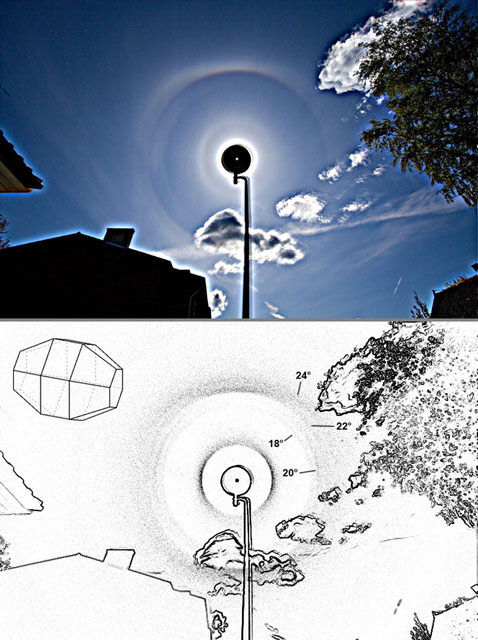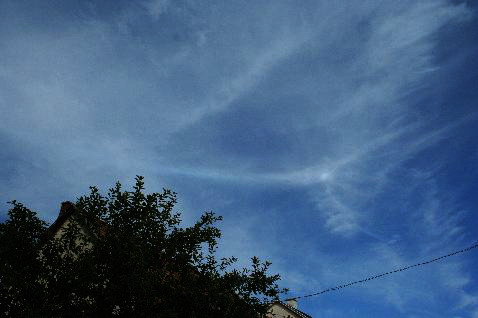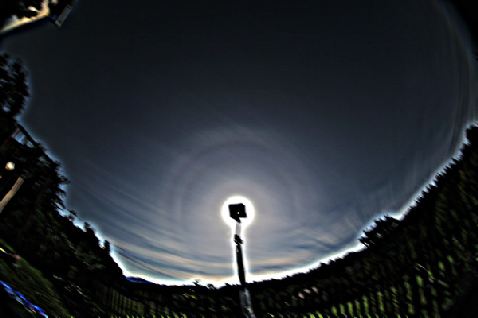Thursday, 18 September 2008
Odd radius halos on 8th May
The photos of this diplay got lost somehow and then found again deep inside my harddrive.
The display shows 9, 18, 20, 22 and 24 degree halos, also 9, 20 and 24 column arcs.
This photo is 9 image stack shot at solar elevation of 46.7 degree and the simulation provided by M.Riikonen is made according to this. Pyramidial columns were used with 14 degree tilts plus crystal populations for 22 halo and its tangent arc.
Sunday, 14 September 2008
Blue spot from Vecsés, Hungary
The image above shows the blue spot on the parhelic circle, photographed on 1 September in Vecsés, Hungary. Click the picture to see the colours in the original version. Its hue seemed almost electric blue compared to the white parhelic circle, and was really conspicuous even to the naked eyes ( 1 – 2 ).
The blue spot can only be observed when the Sun is lower than 32°. It is a halo phenomenon that changes its position and length with solar altitude. When the Sun is 5° high, the blue spot is at 115° azimuth and only 2° long. At solar elevation 25°, it moves to 135° azimuth, and when the Sun is at 32°, the blue spot is positioned in the anthelic region, reaching 180° azimuth and 10° length.
My images were taken between 16:06 and 16:10 local time. The solar altitude in this period was between 32-31°, meaning that the blue spot was in its longest phase and exactly opposite the Sun. The simulation made with HaloSim reveals the position of the blue spot as compared to the 120° parhelia. The crystal population I used was hexagonal plates with 2° tilting angles ( 3 ). The composite image shows the original photo with unsharp masked image and simulation ( 4 ).
The 1 September display lasted a couple of hours. Besides the full parhelic circle, and other, more common halo forms, there was a long-lasting stage with Parry oriented crystals, and another stage with a 46° halo – this latter one was observed by Alexandra Farkas. For further images of the diplay, see Alexandra Farkas’s and my website ( 5 – 6 )
Saturday, 13 September 2008
Odd radius halos in Nydek
After a year of non-pyramidal halo complexes, finally a pyramidal one appeared. On 10 September, I (Martin Popek) observed 9°, 18°, 20°, 23° and maybe a 24° halo, together with weak 9°, both 18° and 23° parhelion, which was separated from the 23° halo. 50 images were stacked using RegiStax. Notice the bad anomalies which are created by Bishop's ring ( 1 - 2 ).
The phenomena formed in thick cirrostratus clouds before the arrival of a warm front. Some meteorogical data are also provided ( 3 - 4 ).
Text: Martin Popek, Matej Grek
The phenomena formed in thick cirrostratus clouds before the arrival of a warm front. Some meteorogical data are also provided ( 3 - 4 ).
Text: Martin Popek, Matej Grek
Wednesday, 3 September 2008
Halo Meeting 2009, Hungary
*** addition 7 December: please note that the date of the meeting has been modified! ***
After the 2006 Artjärvi halo meeting ( 1 ), the next one is to be organised in Hungary. The date of the event is at the end of the summer between 30 August - 1 September 2009. A homepage has been designed for the gathering by Alexandra Farkas and me ( 2 ). In the future this will be the primary site for news and updates.
So far quite a few people have signalled that they’d like to participate, but in order to find out about how many people to expect, please, let me know if you think you’d like to come. Of course, this list will serve now only as an approximation. Also, if you’d like to receive emails about the meeting, or you already have an idea what presentation you'd like to give, let me know about it, too. You can contact me at the following address: ( 3 ).



